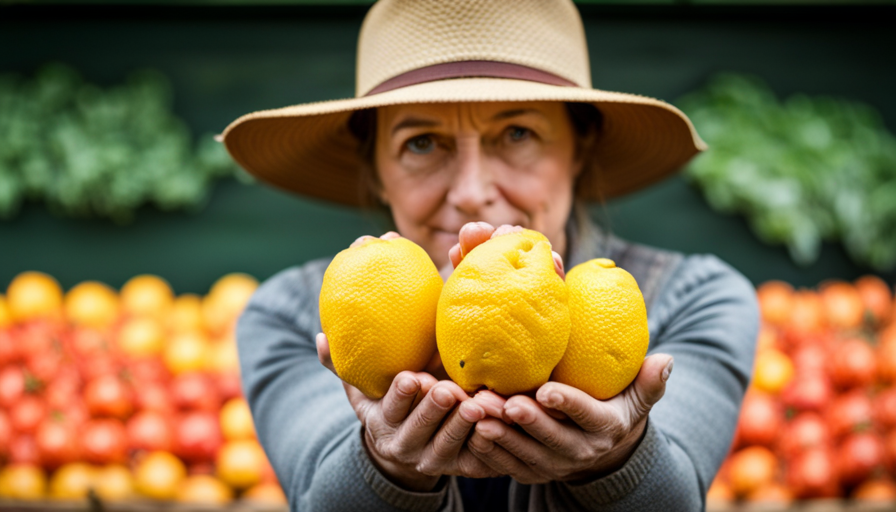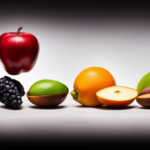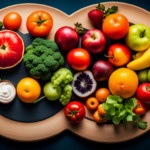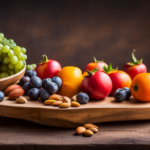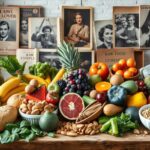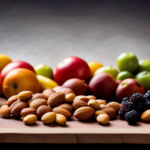As a Registered Dietitian, I often get asked about the popularity of raw food diets. This dietary strategy is based on the idea that eating foods in their raw and unprocessed form provides many health benefits. But what do scientific researches reveal about this?
In recent years, there’s been an increasing interest in plant-based diets such as veganism or vegetarianism, which have helped to promote the idea that all forms of whole foods can provide important nutrients for our bodies. Raw food diets take this concept one step further by advocating for only consuming uncooked fruits, vegetables, grains, nuts and seeds.
In this article, I’ll look at some of the potential pros and cons associated with following a raw food diet, as well as providing practical advice for those who may be considering it.
Overview Of Raw Food Diets
Raw food diets are becoming increasingly popular, and for good reason. They emphasize eating foods that have not been cooked or otherwise processed in any way. This includes fruits, vegetables, nuts, seeds, sprouted grains and legumes, as well as unpasteurized dairy products and unprocessed meats.
Eating raw offers a wide variety of dietary benefits due to the increased nutrient density of these foods compared to their cooked counterparts. The most important aspect of following a raw diet is making sure you get adequate nutrition from all sources by including a variety of raw food sources into your meals.
Ensuring dietary diversity is key to getting essential vitamins and minerals as well as other beneficial compounds like antioxidants which can help protect against disease. Making sure you’re incorporating enough protein-rich items such as nuts, beans and leafy greens is also an important part of ensuring overall health on this type of diet.
Food preparation techniques such as blending, juicing, dehydrating and soaking can help make it easier to incorporate more raw foods into your daily meals without compromising taste or texture. Other methods such as fermentation can further increase the nutritional content of some types of produce while adding unique flavors to dishes that may be unfamiliar at first but quickly become enjoyable once you include them regularly in your meals.
With careful planning and mindful meal preparation habits, anyone looking to switch over to a more plant-based lifestyle could benefit greatly from trying out a raw food diet.
Potential Health Benefits
Raw food diets have become increasingly popular in recent years as people look to adopt healthier lifestyles. This type of diet consists mainly of unprocessed, plant-based foods that are either uncooked or only lightly cooked.
While there is no one-size-fits-all approach when it comes to nutrition, raw food diets can offer a number of potential health benefits. Consuming more fruits and vegetables has been linked to improved exercise habits, better mental health outcomes, and overall well being.
In addition to the physical benefits associated with raw food diets, research also indicates that these types of eating plans may be beneficial for emotional wellness due to their focus on whole foods. Eating fresh produce can help provide essential vitamins and minerals that are needed for optimal functioning.
Furthermore, consuming less processed foods often leads to fewer calories consumed throughout the day since many ready-made meals contain added sugars and fats which contribute extra calories without providing much nutritional value. By swapping out heavily processed items for nutrient dense options such as fruits, vegetables, nuts and seeds, individuals following a raw food plan can meet their daily needs without overeating or feeling deprived.
As we move forward into understanding the full scope of nutritional considerations related to this dietary pattern, further studies will continue to shed light on its impact on our health and wellbeing.
Nutritional Considerations
Raw food diets are becoming increasingly popular, as people look for ways to optimize their health and well-being. But what exactly is a raw food diet and why is it so appealing? As a registered dietitian, I’m here to tell you the nutritional considerations of this type of lifestyle – from nutrient sources to digestive health – in order to help you make an informed decision about whether or not it’s right for you.
Firstly, let’s cover some basics: A raw food diet consists primarily of unprocessed plant foods like fruits, vegetables, nuts and seeds that have been eaten uncooked or heated at temperatures below 118°F (48°C). This means that most grains, legumes and dairy are off limits since they require cooking above those temperatures to be safe to eat. While this may seem limiting at first glance, there’s actually quite a bit of variety available on such a plan.
Fruits and vegetables come in all shapes, sizes and colors – each offering different types of vitamins, minerals and other important nutrients our bodies need. In addition, sprouts provide an excellent source of protein while nut butters offer healthy fats. There’s more than enough options out there!
Digestive health is another factor worth mentioning when talking about raw food diets; namely because many consider them easier on the digestive system due to higher levels of enzymes present in fresh produce. These natural enzymes aid digestion by breaking down difficult-to-digest molecules found in certain whole grains, legumes and meats which can cause discomfort if consumed regularly without proper preparation before eating them.
With this being said though, going completely raw isn’t necessary for optimal digestive function; adding just one or two meals per day with enzyme-rich ingredients could do wonders for your gut health!
The information provided here should give you a good overview of the potential benefits associated with following a raw food diet. Now armed with knowledge regarding nutrition sources and digestive support offered by these types of plans – coupled with its inherent environmental sustainability credentials – it’s up to you decide if pursuing this dietary approach might be suitable for your own personal needs.
Pros And Cons Of A Raw Food Diet
The raw food diet has grown in popularity over the last few years. But, as with any diet, there are pros and cons that need to be considered before making a dietary decision.
From social implications to financial costs, it is important to understand what this type of diet entails. One of the main benefits of eating a raw food diet is that you get all your nutrition from fresh fruits and vegetables without added preservatives or processing methods. Additionally, proponents of the raw food movement cite improved digestion and better energy levels due to higher fiber intake on this type of plan.
However, following a strict raw food regimen can have some drawbacks too; for example, it can limit one’s ability to participate in certain social situations where cooked foods are served – such as dinner parties or family gatherings. Furthermore, purchasing organic produce required by many raw food diets can come at an additional cost compared with conventional alternatives.
It is essential to weigh these potential benefits against any potential risks before committing to a particular dietary lifestyle choice. As we move forward in planning a balanced diet, understanding our own personal needs should shape those decisions accordingly.
Planning A Balanced Diet
The raw food diet is becoming increasingly popular, as it can provide many health benefits. However, transitioning to an entirely raw food diet can be challenging, and it is important to plan a balanced diet in order to get the most nutrition from your meals.
Take Amy for example; she decided to transition to a raw food diet but was unsure how best to do so. After consulting with her registered dietitian, she learned about cooking techniques and portion control that would help her create a healthy and nutritious meal plan. She also discovered some helpful tips on how to shop for foods that were suited for her new dietary needs.
Amy soon realized that there are many creative ways of preparing raw foods without having to sacrifice taste or nutritional value. For instance, she started using high-speed blenders and food processors frequently to incorporate ingredients into smoothies and salads while still keeping them raw.
Additionally, Amy began paying more attention when serving up portions so that each of her meals had the right balance of nutrients needed throughout the day.
Thanks to these simple yet effective strategies, Amy was able to develop a well-balanced raw food diet that worked best for her lifestyle. Now, she enjoys eating fresh vegetables and fruits daily along with other nutrient dense plant-based items like nuts, seeds and sprouted grains – all components crucial for maintaining optimal health!
With this newfound knowledge under her belt, Amy is confident in shopping for the right kinds of foods going forward.
Shopping For Foods
Shopping for foods is an essential part of a successful raw food diet. It’s important to plan your meals in advance and budget appropriately so you don’t overspend on costly ingredients that may not last long. As a registered dietitian, here are some tips I recommend when shopping:
-
Stock up on fresh produce such as fruits and vegetables – they should make up the majority of your diet
-
Buy enough nuts and seeds to create nut butters or sprouts
-
Consider purchasing organic whenever possible
-
Look for frozen fruits and vegetables to add variety to dishes
-
Invest in quality kitchen tools like blenders, juicers, graters, etc.
These strategies can help you stay organized while grocery shopping and ensure that you have all the necessary items while following this lifestyle.
With proper meal planning and budgeting, it will be easier than ever to keep up with a healthy raw food diet. Now let’s talk about prepping and storing these foods!
Prepping And Storing Foods
I’m a big fan of prepping and storing foods because it’s a great way to make sure you always have healthy options on hand.
One of my favorite prepping techniques is to cook a large batch of grains and proteins in advance, so that I can easily add them to salads or meals throughout the week.
I also recommend investing in high quality storage containers that will keep food fresh for longer.
I think that’s why the raw food diet is so popular – because it encourages people to prep and store their food properly.
Prepping Techniques
When it comes to prepping and storing foods, there are a few techniques that can be used depending on the type of food you’re working with.
Dehydrating is great for preserving fruits, vegetables and meats – just think beef jerky! It’s also great for making your own raw snacks and ingredients.
Juicing is another popular technique. This method helps extract all the vitamins, minerals, enzymes and other nutritional components from raw produce that our bodies need. Plus it’s easy to store juice in bottles or jars so you can enjoy them anytime, anywhere.
Finally, freezing can help preserve freshness for longer periods of time when done correctly – by blanching certain fruits and veggies before putting them in the freezer.
These methods allow us to get creative with our recipes while still maintaining nutrition-packed meals without having to worry about spoilage!
Storage Containers
When you’re prepping and storing foods, it’s important to use the right storage containers.
Plastic bags can be a great option for transporting snacks on-the-go or keeping your freshly juiced beverages cool in the fridge.
For longer-term storage, glass jars are preferred as they don’t leach any chemicals into food like some plastic containers may do.
And if you need something that can withstand higher temperatures, metal containers work well when using heating methods such as boiling or steaming.
The key is finding an alternative container that works best for not just preserving the freshness of your food but also providing optimal nutrition!
Eating Out And Eating With Others
The raw food diet has become increasingly popular due to its health benefits. Recent surveys report that up to 3 million Americans have adopted the diet in some form. This number is likely to increase as people become more aware of the potential benefits associated with eating unprocessed foods and avoiding animal products.
One concern for those considering a raw food lifestyle is how it affects socializing, dining out, and eating with family and friends. Fortunately, there are plenty of options available for those on a raw food diet when it comes to dining out or having meals at home with others.
Many restaurants now offer dishes specifically designed for vegans and vegetarians, allowing even those who don’t follow a completely raw food diet to enjoy their meals without compromising taste or nutrition. Additionally, many grocery stores carry an array of vegan-friendly ingredients which can be used to easily add variety to any meal plan.
It’s important to remember that transitioning into a new way of eating doesn’t mean giving up all your favorite foods overnight – rather than skipping meals altogether, consider making small changes over time by adding more whole fruits, vegetables, nuts and seeds into your everyday meals.
It also helps to plan ahead so you know what kind of ingredients you need when shopping or ordering from a restaurant menu. With these strategies in mind, anyone can make successful dietary changes while still maintaining good relationships with family and friends through shared meals.
Tips For Transitioning To A Raw Food Diet
Making the transition to a raw food diet can seem daunting at first, but with some planning and preparation it doesn’t have to be. Meal planning is an important step that will help you stay on track when transitioning to this type of eating pattern.
Begin by looking through recipes online or in books devoted to raw foods and make a list of meals you’d like to try. This will give you an idea of all the delicious dishes you can enjoy! Additionally, spend time prepping your ingredients ahead of time so that when mealtime comes around everything is ready for assembly. It’s also helpful to invest in quality kitchen tools such as blenders, spiralizers, and mandolines which come in handy when preparing raw foods.
You may find yourself feeling overwhelmed from time to time while making changes to your dietary habits; don’t feel discouraged! Taking small steps toward incorporating more raw plant-based foods into your daily routine is often easier than adopting an entirely new lifestyle overnight. Experimenting with different flavors and textures helps keep things interesting and allows you to gain confidence in the kitchen.
Transitioning slowly gives your body ample opportunity to adjust without being shocking or overwhelming.
As with any major change, having support throughout your journey makes both maintenance and success much easier. Seek out friends who share similar interests as well as professionals such as nutritionists or registered dietitians who are knowledgeable about healthy nutrition habits and how they relate to overall health outcomes.
Look for local cooking classes where you can learn tips straight from experts, get inspired by other people’s experiences, and most importantly – have fun! Making the switch away from processed fare towards whole plant-based nourishment should be enjoyable!
With these supportive strategies in place, supporting your health just got simpler.
Supporting Your Health
Making the switch to a raw food diet can be challenging, but it doesn’t have to be intimidating. With some planning and forethought, you can make this transition with ease.
One of the most important aspects of transitioning is staying hydrated; since many raw foods are made up mostly of water, your body needs that extra boost during this time. It’s also essential to incorporate lifestyle changes such as exercise into your daily routine – even if it’s just taking a 10-minute walk each day – so that your body can gradually adjust to its new eating habits.
Additionally, nutritionists recommend supplementing your diet with vitamins and minerals to ensure you’re getting all the nutrients necessary for optimal health when consuming a primarily raw food diet. When selecting supplements, look for those that are specifically designed for individuals on plant-based diets.
Additionally, consider adding probiotics like yogurt or kefir to help promote healthy digestion and gut health while you transition.
While there are numerous benefits associated with following a raw food regimen, it’s important to understand potential side effects before embarking on this journey. These may include digestive issues due to lack of sodium in certain meals or difficulty absorbing key vitamins and minerals from uncooked produce – both topics we will discuss more thoroughly in our next section about ‘Supporting Your Health’.
Potential Side Effects
Eating raw food is often seen as a symbol of pureness and promise to the body. It can be an escape from the heavy pressure of societal norms for junk food, or simply a way to take charge of one’s own wellbeing. After all, it’s in our nature to look after ourselves – and eating raw foods can be part of that journey.
However, it’s important to remember that there are potential side effects associated with following this type of diet. Firstly, because raw fruits and vegetables don’t contain many calories they may lead to weight loss which at times could become dangerous if not monitored properly by a registered dietitian.
Additionally, some people who follow a raw food diet put themselves at risk for vitamin B12 deficiency since its only found in animal sources such as meat and dairy products. Finally, those who choose to eliminate cooked grains from their diets might miss out on essential fiber needed for healthy digestion and nutrient absorption.
Though opting for a raw food diet has numerous health benefits when done right, it is best practice to consult with a certified nutrition professional before beginning any dietary change, especially drastic ones like this one. Supplementation may need to be considered depending on individual needs and goals in order to prevent any possible deficiencies caused by changes in consumption patterns over time.
Supplementation
I often get asked about supplementation trends when it comes to raw food diets.
It’s important that individuals following a raw diet understand the potential for nutritional deficiencies, since many of the staple foods are absent from this dietary approach.
For instance, B12 is found in animal-based products and isn’t present in plant-based items; thus, supplementing with B12 may be necessary if you follow a raw vegan lifestyle.
Additionally, some other vitamins like D3 can also be supplemented depending on your specific needs as well as what sources of vitamin D you have access to.
It’s essential to note that supplements should never replace whole foods; they simply offer an additional layer of support for those who need it or choose to incorporate them into their lifestyle.
Talk with your healthcare provider prior to starting any supplements so that you can ensure safe use and avoid potential drug interactions.
Overall, proper nutrition is extremely important no matter what type of eating pattern you prefer!
With all this being said, addressing cravings caused by nutrient deficiencies is another way to help maintain optimal health while sticking with a raw food diet long-term.
Addressing Cravings
Eating a raw food diet can be incredibly satisfying when cravings strike. It’s like taking a bite out of the garden itself – crunchy, juicy, and full of flavor! As a registered dietitian, I believe that addressing cravings is an important part of any healthy eating plan.
For those on a raw food diet, there are plenty of options for both sweet and savory dishes to help satisfy your hunger without compromising nutrition or taste. One way to address emotional eating is by creating meals with nutrient-dense ingredients. Foods like nuts and seeds are packed with protein and healthy fats which help promote feelings of satiety while also providing essential vitamins and minerals.
Fruits and vegetables provide fiber as well as natural sweetness to help you get through the day without unhealthy snacks in between meals. There are even recipes available online for delicious smoothies made from whole fruits, greens, herbs, and spices – perfect for getting all the nutrients you need without having to cook anything!
It’s important to remember that snacking doesn’t have to mean reaching for something processed or sugary; instead it can be an opportunity to nourish yourself with wholesome foods that will leave you feeling energized rather than sluggish afterwards. With so many tasty options available on a raw food diet, it’s easy to find ways to curb cravings while still enjoying what you eat.
Moving forward into resources for more information…
Resources For More Information
Now that you’ve addressed your cravings and have the tools to create a sustainable raw food diet, it’s time to start thinking about eating out and socializing. Eating raw foods can be challenging when dining out or attending social events, as most restaurants and gatherings are not prepared for specialty diets. Don’t worry though – with a few simple strategies, you can still enjoy yourself without compromising on health!
Here are some tips for success if you’re trying to stick to your raw food diet while dining out:
-
Look up menus in advance so you know what options may be available.
-
Ask questions of the waiter/waitress regarding ingredients and preparation techniques.
-
Request special accommodations such as no oil or additional vegetables instead of starches.
-
Bring snacks with you just in case there aren’t suitable options at the restaurant.
It is also important to remember that enjoying a meal out isn’t only about nourishment – it’s also about connecting with friends and family. Socializing doesn’t mean always having food involved — consider other activities like going for walks or hikes, going bowling, playing board games, or watching movies together.
When it comes down to it, remember that everyone has different dietary needs and preferences; respect others’ choices whether they align with yours or not.
With these tips in mind, balance is key when incorporating a raw food diet into any lifestyle.
What is the Scientific Basis for the Popularity of Raw Food Diet?
The science behind raw food diet revolves around the belief that cooking destroys enzymes and nutrients in food. Proponents argue that raw foods retain more vital nutrients and aid digestion. However, research suggests that certain cooking methods can enhance the bioavailability of nutrients, making the validity of raw food diet controversial.
Conclusion
The raw food diet has grown in popularity for a number of reasons. It is based on the belief that cooking destroys essential enzymes and nutrients found naturally in foods. Proponents of this diet also suggest it can help to improve digestion, boost energy levels, and even aid with weight loss.
As a registered dietitian, I recognize there are benefits associated with eating more fresh fruits and vegetables. However, I believe that mindful dietary choices should be made when considering any type of strict dietary restriction.
When choosing a healthy lifestyle plan, it’s important to consider all aspects including nutrition quality, balance, variety and sustainability over the long-term – not just short-term goals or quick fixes. Eating mainly uncooked plant-based foods may offer some health benefits but could potentially also lead to inadequate nutrient intake due to limited food sources unless you have access to high quality produce year-round. Additionally, following this type of diet means having adequate knowledge about proper food safety practices such as washing hands thoroughly before preparation and storage solutions like refrigeration.
In my opinion, an overall balanced approach towards eating is the most beneficial for good health which includes consuming various cooked and raw foods from each food group while focusing on whole grains, lean proteins and mono/poly unsaturated fats within caloric needs for your individual body makeup.
Frequently Asked Questions
How Long Does It Take To Transition To A Raw Food Diet?
Making the transition to a raw food diet might feel daunting, but it doesn’t have to be. It’s all about preparation time and meal planning – if you’ve got those two things down pat, the transition can take as little as a few days!
As a registered dietitian, I recommend taking the leap with confidence. With some good ol’ fashioned elbow grease and dedication, you’ll find yourself on your way to healthier eating habits in no time at all.
What Types Of Foods Can I Eat On A Raw Food Diet?
A raw food diet is a great way to get more nutrition from the foods you eat. It consists of unprocessed and uncooked plant-based foods like fruits, vegetables, nuts, seeds, sprouts and seaweeds.
To make things easier when transitioning to this lifestyle, there are many delicious raw substitutions for popular cooked dishes such as sushi rolls made with carrots instead of rice or hummus with avocado instead of chickpeas.
Getting creative in the kitchen can be fun and allows you to explore new flavors while following your dietary goals. With some practice, anyone can become an expert at meal prepping on a raw food diet!
What Are The Long-Term Effects Of A Raw Food Diet?
A raw food diet sounds like a great way to get healthy, but what are the long-term effects?
As an experienced registered dietitian, I can tell you that while there are some potential benefits of eating mostly uncooked foods, it’s important to be mindful of possible nutrient deficiencies and energy levels. Eating only raw plant foods means missing out on key nutrients found in cooked options, such as Vitamin B12 – something your body needs for optimal health!
Additionally, you may find yourself feeling fatigued more often due to your body having to work harder to digest raw food. So if you choose this lifestyle, make sure you’re supplementing adequately and listening carefully to your body’s cues.
How Much Money Does A Raw Food Diet Cost?
Eating a raw food diet can be quite affordable, but the cost will depend on several factors such as your location and how often you plan to eat out.
Generally speaking, when done correctly, this type of diet typically results in significant cost savings due to minimal processing costs for ingredients like fruits and vegetables.
Additionally, since most processed foods are avoided, there is less temptation to overspend while grocery shopping.
As a dietitian, I recommend creating a budget before starting any new eating plan so that you know what kind of money you’re working with!
Is A Raw Food Diet Safe For Pregnant Women?
When it comes to lifestyle choices and eating habits during pregnancy, many women are often concerned about the safety of a raw food diet.
With so much conflicting information out there, it can be difficult to know what’s right for you and your baby.
As a registered dietitian, I’m here to tell you that while a raw food diet is generally safe for pregnant women with no existing health issues, such as diabetes or high blood pressure, they should always consult their doctor first before making any dietary changes.
Eating nutrient-rich fruits and vegetables in their natural state has proven benefits when consumed in moderation – think crunchy carrots, juicy apples, sweet strawberries – all packed with essential vitamins and minerals!
With careful planning, mindful portion control and regular checkups with your doctor or midwife, following a raw food diet during pregnancy could provide a range of nutritional advantages without putting your baby at risk.
Conclusion
The raw food diet has been gaining popularity in the past few years for its perceived benefits. However, it is important to understand that this type of diet may not be suitable for everyone and can even come with certain risks if not done properly.
Despite its many potential drawbacks, a raw food diet could still be a great option for those who are looking for an easy way to improve their overall health.
It’s ironic how something so simple as eating mostly unprocessed foods can have such positive effects on our bodies! But while there is certainly no one-size-fits-all approach when it comes to nutrition, taking the time to research and learn about the pros and cons of any dietary change you make will help ensure that your body gets all the nourishment it needs.
As always, consulting with a registered dietitian will also provide invaluable advice tailored specifically to meet your individual nutritional needs.


